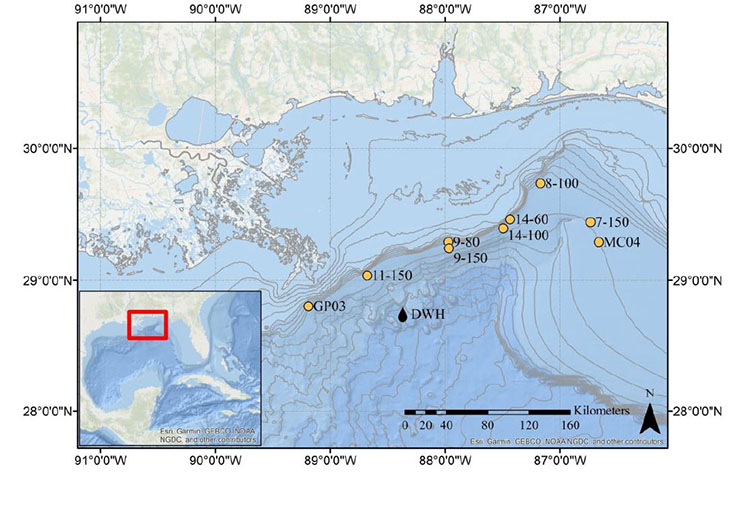Written by Kristen Kusek, Former Communications Director for USF CMS
ST. PETERSBURG, FL – The most recent assessment of the tilefish population offers sweet relief to those who enjoy the savory succulence of this slow-growing fish that roams the deeper waters of the Gulf of Mexico. Tilefish, which tastes similar to lobster or crab, is sustainably managed and regularly finds itself served up baked, broiled, or grilled on menus in Florida – easily fetching $29 as a mouth-watering entrée.
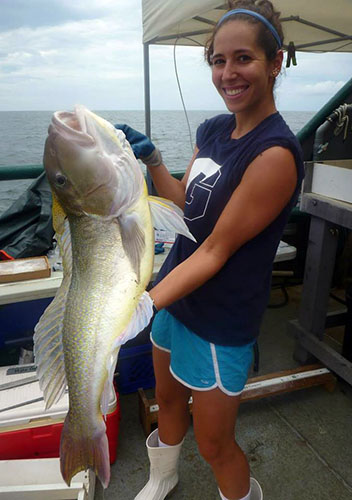
The lead author, Susan Snyder, holds a tilefish caught for the study in the northern Gulf of Mexico.
But a recent study published recently in Environmental Toxicology and Chemistry by scientists at the USF College of Marine Science (USF CMS) offers reasons for
concern.
The USF CMS has been leading a large consortium of scientists studying the widespread impacts of the historic Deepwater Horizon oil spill since the well blew in 2010, and the latest results pertaining to tilefish are alarming, said lead author Susan Snyder who is pursuing her doctoral degree. Snyder led a six-year effort to sample tilefish in the northern Gulf of Mexico from nine areas close to the spill, from 2012 to 2017.
While the situation hasn’t yet reached the fisheries management equivalent of a four-alarm fire, the team is feeling the heat in the analyses.
Over the course of the study the fish experienced a 2.8-fold increase in their exposure to the most toxic chemical portion of crude oil called PAH, or polycyclic aromatic hydrocarbons. And it’s a good thing people don’t eat the liver of the tilefish – only its flesh – because the team found a 53 percent decline in liver lipids, which are one indicator of overall health. The liver breaks down fats for energy; a decrease in lipids indicates compromised energy efficiency.
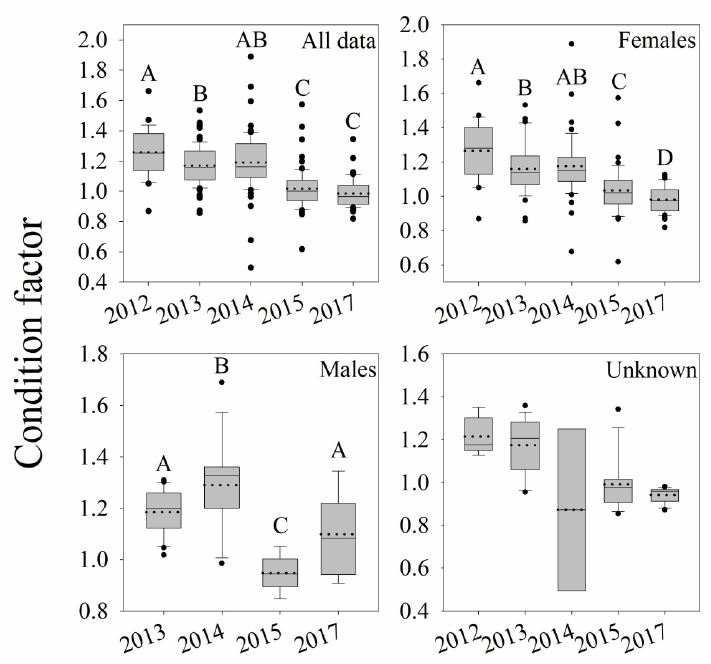
Graph showing the overall decline in the Fulton’s condition factor (K) for tilefish sampled between 2012 and 2017. The Fulton’s condition factor a metric routinely used by fisheries biologists that indicates the weight of a fish at a certain length. The letters (ABC) denote significantly different years.
The weight of the fish caught for the study also declined by 22 percent, as measured
by a metric routinely used by fisheries biologists called the Fulton’s condition factor.
The average tilefish caught for the survey was about 60 centimeters in length–nearly
two feet long. In 2012, a tilefish that long weighed about 7.5 pounds but in 2017
a 60-centimeter-long tilefish weighed closer to 6 pounds.
“The fish didn’t exactly get to skinny and malnourished over the course of the study, but there’s an obvious declining trend in condition factor (specifically weight) over time,” Snyder said. “We always need more data but what we showed is a correlation between the chronic exposure to oil, a decline in the Fulton condition factor, and a decrease in the level of lipids in the liver.”
PAH: the IPA of the Sea?
Generally speaking, fish are pretty good at metabolizing PAH similar to the way humans metabolize alcohol, Snyder said. But too much causes problems.
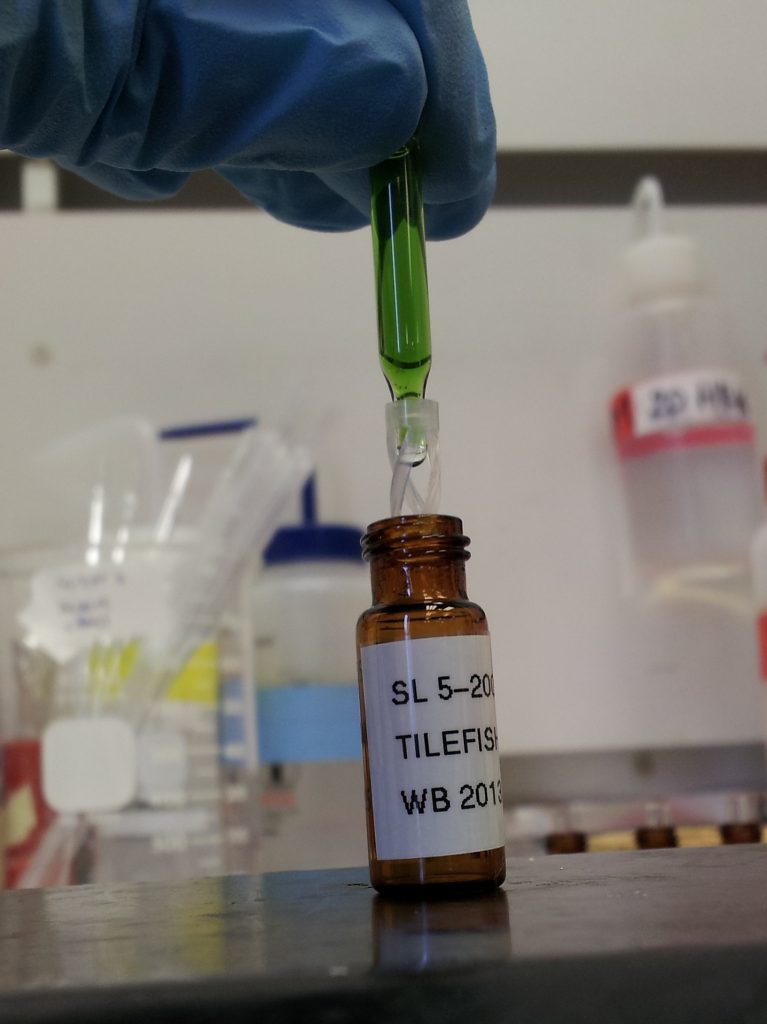
For this study the team analyzed more than 250 tilefish bile samples,the green liquid shown here, for metabolites of PAH. PAH ismetabolized by the liver and isthe most toxic component of oil.
“The whole process takes energy away from other metabolic processes important to overall
health, and if you have chronic exposure, you will get liver damage,” she said. The
liver is responsible for maintaining balance in the body. It plays a key role in the
overall health of an organism. That’s likely why the fish were smaller over time,
Snyder said. They had to spend a lot of energy just to break down the oil instead
of healthier metabolic processes like gaining lipid or muscle. If the trend continues
it could be a problem for a big commercial fishery because if fish get smaller over
time, fishers need to catch more of them.
In addition to reducing growth, PAHs can harm a fish’s ability to reproduce, impair its cardiac function, cause cancerous lesions to form on its liver, and more.
It could be particularly taxing to females, Snyder said. “Fattier female fish produce a higher number and better quality of eggs,” she said, expressing a need to examine tilefish gonads in future studies.
Tilefish: bigger and better in the burrow
The team had suspected that tilefish were among the most vulnerable of the deep sea-roaming species, which includes the likes of grouper, red snapper and king snake eels. Tilefish are massive and can grow to 30 pounds and live up to 45 years, and they prefer to spend their time in the mud where they dig funnel-shaped burrows for protection from predators. They also like to dine on crabs and other smaller fish that hang out near the burrows.
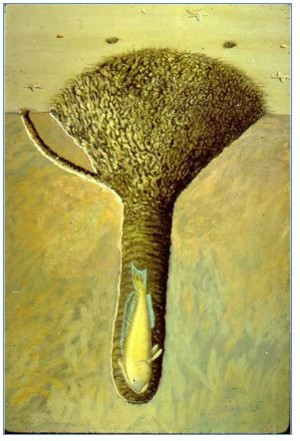
Illustration showing what a tilefish burrow looks like on the seafloor. Credit: Dr. Ken Able
The problem is the burrows become a sticky magnet for the toxic parts of the crude
oil that sink to the bottom after a spill. Scientists at the USF CMS estimated in
a previous study that 20-30 percent of the four million barrels of the Deepwater Horizon
spill was deposited on the seafloor. Plus, even after a spill ends the toxic components
can become resuspended in the water column from deep sea currents, Snyder said, which
could be one reason the level of PAH recorded after the spill ended in 2010 actually
increased over time.
“We don’t know for sure the reasons the PAHs increased over time,” Snyder said. “They could be subject to weather events that stir up the seafloor, new sources of oil, and more.”
What they do know for sure is the results of this study could have serious consequences for the long-term viability of the tilefish population.
“Our work confirms the need to continuously monitor the health of organisms in the Gulf of Mexico exposed to the spill,” Snyder said. This study was funded by a grant from the Gulf of Mexico Research Initiative through the Center for Integrated Modeling and Analysis of the Gulf Ecosystem (C-IMAGE I, C-IMAGE II, C-IMAGE III).
